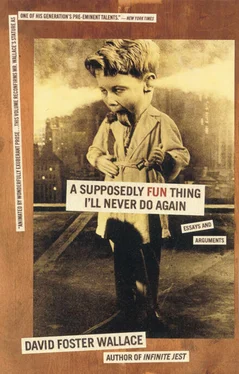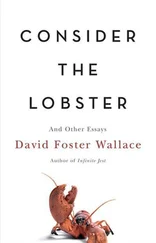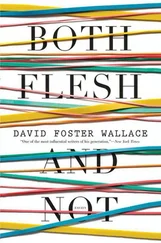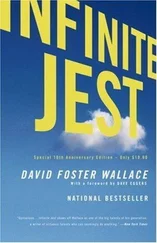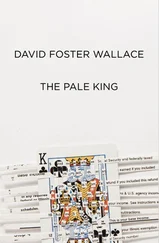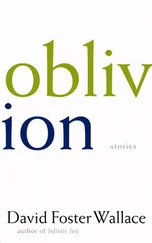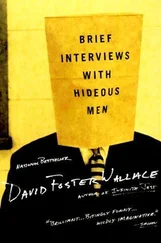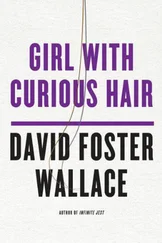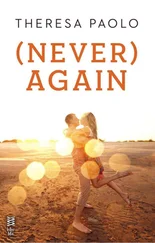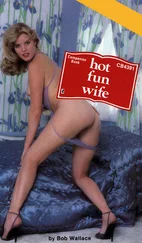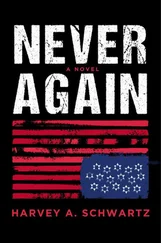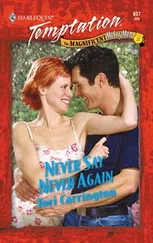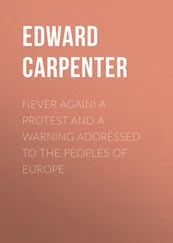61(not to mention for being (from various reviews) “overwrought,” “incoherent,” “ too much ”)
1Comprising Washington, Montreal, LA, Cincinnati, Indianapolis, New Haven, and Long Island, this is possibly the most grueling part of the Association of Tennis Professionals’ yearly tour, with three-digit temperatures and the cement courts shimmering like Moroccan horizons and everyone wearing a hat and even the spectators carrying sweat towels.
2Joyce lost that final to Thomas Enqvist, now ranked in the ATP’s top twenty and a potential superstar and in high-profile attendance here at Montreal.
3Tarango, 27, who completed three years at Stanford, is regarded as something of a scholar by Joyce and the other young Americans on tour. His little bio in the 1995 ATP Player Guide lists his interests as including “philosophy, creative writing, and bridge,” and his slight build and receding hairline do in fact make him look more like an academic or a tax attorney than a world-class tennis player. Also a native Californian, Tarango’s a friend and something of a mentor to Michael Joyce, whom he practices with regularly and addresses as “Grasshopper.” Joyce — who seems to like pretty much everybody — likes Jeff Tarango and won’t comment on his on-court explosion at Wimbledon except to say that Tarango is “a very intense guy, very intellectual, that gets kind of paranoid sometimes.”
4Title sponsors are as important to ATP tournaments as they are to collegiate bowl games. This year the Canadian Open is officially called the “du Maurier Omnium Ltée.” But everybody still refers to it as the Canadian Open. There are all types and levels of sponsors for big tennis tournaments — the levels of giving and of commensurate reward are somewhat similar to PBS fundraising telethons. Names of sponsors are all over the Canadian Open’s site (with variations in size and placement corresponding to levels of fiscal importance to the tournament), from the big FedEx signs over the practice courts to the RADO trademark on the serve-speed radar display on the show courts. On the scarlet tarp and the box seats all around the Stadium and Grandstand Courts are the names of other corporate sponsors: TANDEM COMPUTERS/APG INC., BELL SYGMA, BANQUE LAURENTIENNE, IMASCO LIMITÉE, EVANS TECHNOLOGIES INC., MOBILIA, BELL CANADA, ARGO STEEL, etc.
5Another way to be a sponsor: supply free stuff to the tournament and put your name on it in really big letters. All the courts’ tall umpire-chairs have a sign that says they’re supplied by TROPICANA; all the bins for fresh and unfresh towels say WAMSUTTA; the drink coolers at courtside (the size of trash barrels, with clear plastic lids) say TROPICANA and EVIAN. The players who don’t individually endorse a certain brand of drink tend as a rule to drink Evian, orange juice being a bit heavy for on-court rehydration.
6Most of the girlfriends have something indefinable about them that suggests extremely wealthy parents whom the girls are trying to piss off by hooking up with an obscure professional tennis player.
7The term “seeding” comes from British horticulture and is pretty straightforward. A player seeded First is expected statistically to win, Second to reach the finals, Third and Fourth the semis, etc. A player who reaches the round his seed designates is said to have “justified his seed,” a term that seems far more rich in implications and entendres. Serious tennis is full of these multisemiotic terms—“love,” “hold” and “break,” “fault,” “let” as a noun, “heat,” “moon,” “spank,” “coming in,” “playing unconscious,” and so on.
8Except for the four Grand Slams, no tournament draws all the top players, although every tournament would obviously like to, since the more top players are entered, the better the paid attendance and the more media exposure the tournament gets for itself and its sponsors. Players ranked in the world’s top twenty or so, though, tend to play a comparatively light schedule of tournaments, taking time off not only for rest and training but to compete in wildly lucrative exhibitions that don’t affect ATP ranking. (We’re talking wildly lucrative, like millions of dollars per annum for the top stars.) Given the sharp divergence of interests between tournaments and players, it’s not surprising that there are Kafkanly complex rules for how many ATP tournaments a player must enter each year to avoid financial or ranking-related penalties, and commensurately complex and crafty ways players have for getting around these rules and doing pretty much what they want. These will be passed over. The thing to realize is that players of Michael Joyce’s station tend to take way less time off; they try to play just about every tournament they can squeeze in unless they’re forced by injury or exhaustion to sit out a couple weeks. They play so much because they need to, not just financially but because the ATP’s (very complex) set of algorithms for determining ranking tends to reward players for entering as many tournaments as they can.
And so even though several of the North American hard-court circuit’s tournaments are Super 9’s, a fair number of top players skip them, especially European clay-court players, who hate Deco Turf and tend to stick to their own summer clay-court circuit, which is European and comprises smaller and less lucrative tournaments (like the Dutch Open, which is concurrent with the Canadian and has four of the world’s top twenty entered this year). The clay-courters tend to pay the price for this at the U.S. Open, which is played on hard sizzling Deco Turf courts.
9There is here no qualifying tournament for the Qualies itself, though some particularly huge tournaments have meta-Qualies. The Qualies also have tons of wild-card berths, most of whom here are given to Canadian players, e.g. the collegian that Michael Joyce is beating up on right now in the first round.
10These slots are usually placed right near the top seeds, which is the reason why in the televised first rounds of major tournaments you often see Agassi or Sampras smearing some totally obscure guy — that guy’s usually a qualifier. It’s also part of why it’s so hard for somebody low-ranked enough to have to play the Qualies of tournaments to move up in the rankings enough so that he doesn’t have to play Qualies anymore — he usually meets a high-ranked player in the very first round and gets smeared.
11Which is another reason why qualifiers usually get smeared by the top players they face in the early rounds — the qualifier is playing his fourth or fifth match in three days, while the top players usually have had a couple days with their masseur and creative-visualization consultant to get ready for the first round. If asked, Michael Joyce will detail all these asymmetries and stacked odds the same way a farmer will speak of poor weather, with an absence of emotion that seems deep instead of blank.
12(pronounced KRY-chek)
13At a certain point this summer his ranking will be as high as 62.
14It turns out that a portion of the talent required to survive in the trenches of the ATP Tour is emotional: Joyce is able to keep from getting upset about stuff that struck me as hard not to get upset about. When he points out that there’s “no point” getting exercised about unfairnesses you can’t control, I think what he’s really saying is that you either learn how not to get upset about it or you disappear from the Tour. The temperamental behavior of many of the game’s top players — which gives the public the distorted idea that most pro players are oversensitive brats — is on a qualifier’s view easily explainable: top players are temperamental because they can afford to be.
15The really top players not only have their expenses comped but often get paid outright for agreeing to enter a tournament. These fees are called “guarantees” and are technically advances against prize money: in effect, an Agassi/Sampras/Becker will receive a “guarantee” of the champion’s prize money (usually a couple hundred thousand) just for competing, whether he wins the tournament or not. This means that if top seed Agassi wins the Canadian Open, he wins $254,000 U.S., but if he loses, he gets the money anyway. (This is another reason why tournaments tend to hate upsets, and, some qualifiers complain, why all sorts of intangibles from match scheduling to close line-calls tend to go the stars’ way.) Not all tournaments have guarantees — the Grand Slams don’t, because the top players will show up for Wimbledon and the French, Australian, and U.S. Opens on their own incentive — but most have them, and the less established and prestigious a tournament, the more it needs to guarantee money to get the top players to come and attract spectators and media (which is what the tournament’s title sponsor wants, very much).
Читать дальше
